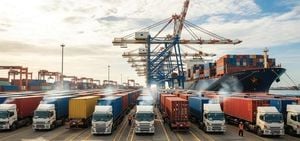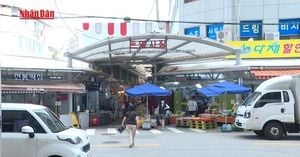The Philippines is facing significant hurdles to its economic growth as detailed in recent reports by the International Monetary Fund (IMF) and local experts, which argue there is more to the narrative than is often presented by government officials. While the country boasts solid economic figures, many Filipinos remain mired in poverty and unemployment, pointing to systemic issues affecting broader prosperity.
According to the IMF, the Philippines has made strides but still lags behind its Southeast Asian counterparts on pivotal metrics like economic openness, business regulation, and infrastructure quality. Specifically, the IMF report notes, "The Philippines is facing significant hurdles...to attract private investment and drive long-term productivity growth." This is particularly concerning as the country attempts to modernize its economy.
The significance of infrastructure issues cannot be overstated, with recommendations for urgent improvements across the board. The IMF highlights underdeveloped road networks and inadequate electricity access as barriers to economic activity. Most alarmingly, the high cost of internet service—significantly higher than neighboring Vietnam—limits the ability of businesses to function optimally, establishing barriers to entry especially for small enterprises.
While efforts like public-private partnerships are aimed at addressing these challenges, the IMF advocates for necessary reforms to fundamentally improve the environment for private investment. The Philippines also needs to create approximately 12 million jobs by 2050, about 450,000 new jobs annually, to accommodate its growing workforce.
Local voices echo these sentiments, emphasizing the plight of everyday workers. Rene G. Romero, Chair of the Pampanga Chamber of Commerce, has been vocal about the necessity of raising the minimum wage to at least ₱1,000 per day, acknowledging the disparity between current wages and the cost of living. He states, "Raising the minimum wage must be legislated as an across-the-board increase to spell out uniform wage protection for all workers." This move, he argues, would also spur economic growth by promoting local consumption and assisting workers to live with dignity.
Romero’s arguments are underpinned by the recognition of flaws within current policy approaches, which he believes primarily benefit the economic elites. The concentration of wealth, which Romero describes as an outcome of mismanaged resources, along with systemic corruption, poses significant problems for equitable development.
Complementing Romero’s view is economist Carlos A. Africa, who sheds light on the disconnect between reported economic growth and the realities experienced by average Filipinos. His analysis indicates, "Prosperity is gushing up. There’s no trickle down." This claim is supported by evidence showing stagnated job creation alongside rising GDP figures, particularly highlighting underperformance within the agriculture sector.
Despite government assertions of growth, Africa’s insights draw attention to increasing poverty rates. According to him, self-rated poverty levels have spiked to alarming percentages, indicating the struggles faced by many Filipinos to obtain the necessities of life.
Indeed, the agricultural sector—a cornerstone of the Philippine economy—has suffered significant setbacks, leading the country to rely heavily on food imports since 2022. Africa elucidates the need for national industrialization, advocating for structures to support this shift. “Manufacturing is at its smallest share of the GDP,” he notes, emphasizing the necessity of revitalizing this sector to create jobs and increase economic resilience.
His co-speaker, Rosario Bella Guzman, intensifies the call for structural reforms, rejecting neoliberal approaches and advocating for national industrialization as the path forward. Guzman emphasizes, "A solid economic plan based on agriculture is a chance for the Philippines to reboot its economy," signaling the need to prioritize local production over reliance on imports.
Both experts underline the urgency of collaboration between the government and private sectors to address these pressing economic issues. Effective policy reforms are required to revitalize the industrial base, improve educational opportunities, and eradicate joblessness through workforce development initiatives.
Further good news may be on the horizon as more immediate actions are hinted at from the Bangko Sentral ng Pilipinas (BSP). Governor Eli Remolona Jr. recently indicated the possibility of easing monetary policy to bolster growth, with anticipated adjustments to interest rates and reserve requirements to accommodate banks. This shift could serve to stimulate both investment and consumer spending.
Despite these positive indicators, many remain skeptical. They assert addressing the pronounced economic inequities must take precedence to reflect true progress. Without improving the livelihood of ordinary citizens, even the most favorable economic forecasts ring hollow.
To encapsulate, the Philippine economy presents both opportunities and significant challenges as it approaches 2025. While reports project growth, the human element—reflective of real suffering and systemic inertia—calls for urgent reforms aimed at leveling the economic playing field. Whether it’s raising wages, developing infrastructure, or pursuing industrialization, the resources and resolve of the government may well dictate the Philippines’ economic future. Ensuring every Filipino thrives is not merely beneficial; it is fundamental for sustainable growth and national progress.



